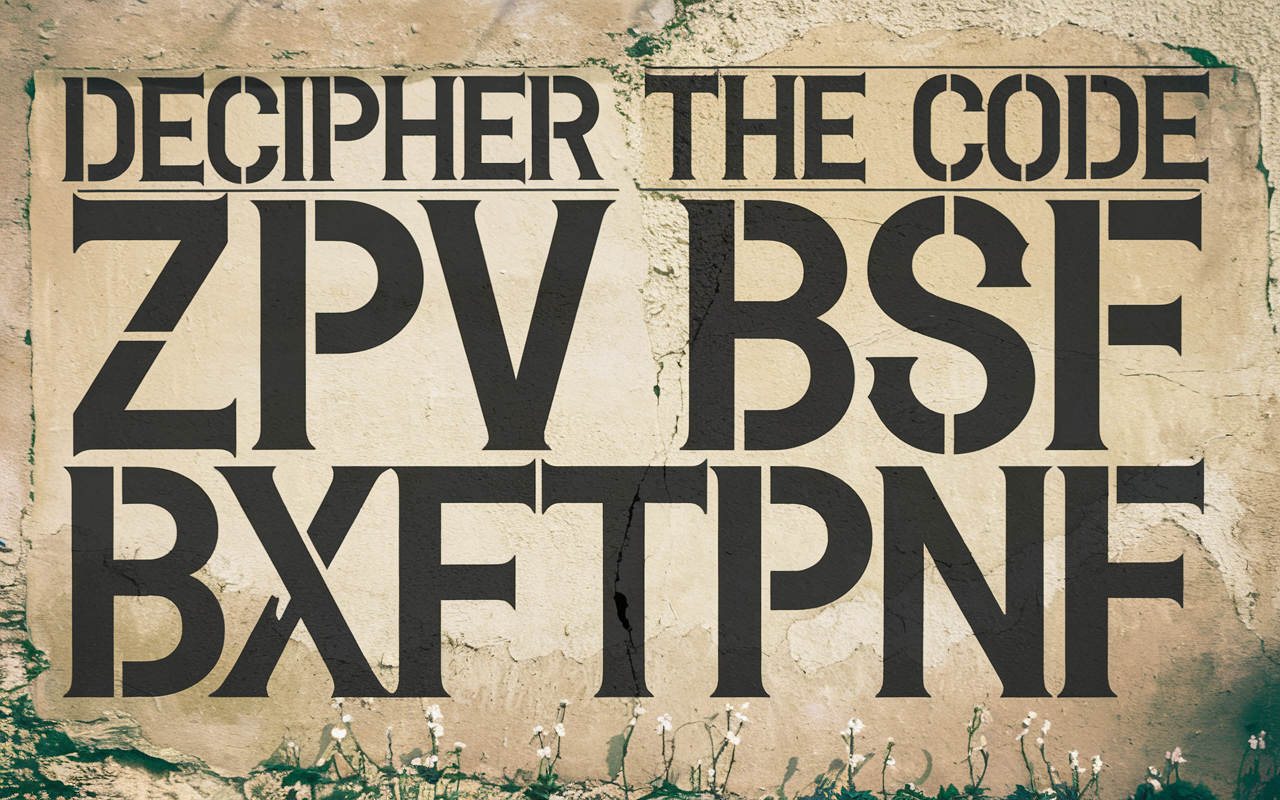Introduction to decipher the code zpv bsf bxftpnf
Have you ever stumbled upon a mysterious code and felt the urge to crack it? The phrase “zpv bsf bxftpnf” might seem like a jumble of letters, but hidden within is an intriguing challenge waiting to be unraveled. Deciphering codes has fascinated people for centuries, from ancient civilizations to modern-day puzzle enthusiasts. Whether you’re a curious beginner or an experienced cryptologist, understanding how to decipher the code zpv bsf bxftpnf can open up a world of secrets and fun. Get ready to dive into the captivating realm of ciphers as we explore their history, techniques for cracking them, and practical applications in our everyday lives. Let’s embark on this journey together!
The History of decipher the code zpv bsf bxftpnf
The phrase “zpv bsf bxftpnf” is a classic example of a Caesar cipher, one of the oldest encryption techniques. Its roots can be traced back to ancient Rome, where Julius Caesar famously used it for secure communication.
This simple substitution cipher shifts letters in the alphabet by a fixed number. In our case, each letter in “zpv bsf bxftpnf” has been moved forward by one position. Thus, Z becomes A, P turns into Q and so on.
Ciphers like this gained popularity during wartime when secret messages were crucial for strategy. Cryptography evolved through centuries as both art and science.
As technology advanced, more complex ciphers emerged alongside historical events that demanded heightened security measures. Today’s fascination with deciphering codes harks back to these earlier innovations, making it relevant even now in games and puzzles enjoyed worldwide.
Common Techniques for Cracking Ciphers
Cracking ciphers can be a fascinating challenge. There are several techniques that enthusiasts and cryptographers use to decode messages effectively.
One common method is frequency analysis. This involves studying the frequency of letters in the ciphertext. In many languages, certain letters appear more frequently than others. For instance, vowels often dominate English texts.
Another approach is pattern recognition. Ciphers often have repeating patterns or structures that can help identify potential substitutions or shifts in a simple substitution cipher.
Brute force attacks are also popular for simpler codes. This technique involves systematically trying every possible key until the correct one is found.
Contextual clues play an essential role as well. Understanding the subject matter or context behind the code can provide insights into likely words or phrases used within it.
Each technique brings its own set of challenges and rewards, making deciphering codes an engaging pursuit for many puzzle lovers.
ALSO READ: Journey to Revelation: The Enigma of 1772451126
Steps to Deciphering ZPV BSF BXFTPNF
To start deciphering the code ZPV BSF BXFTPNF, identify the type of cipher used. This specific message employs a Caesar cipher, where each letter shifts by a fixed number.
Next, determine the shift value. For many basic ciphers, it’s common to try shifting letters back by 1 through 25 positions. Taking ZPV as an example, shifting backward three spaces leads us to “YOU.”
Once you decode each segment using this method, you will reveal meaningful words and phrases hidden within the jumbled text.
After aligning the letters accurately, piece together your findings into coherent sentences. This helps in understanding any context or message contained in it.
Practice makes perfect! Continue experimenting with various texts to enhance your skills over time. The more you engage with different ciphers like these, the easier they become to crack!
Real-Life Examples and Uses of Ciphers
Ciphers have played crucial roles throughout history, often behind the scenes of significant events. During World War II, for instance, the Enigma machine was pivotal in German communications. Allied forces worked tirelessly to crack its code.
In modern times, ciphers find a place in digital security. Encryption protects sensitive data from prying eyes online. It safeguards everything from personal emails to financial transactions.
Even social media platforms use encrypted messages to ensure privacy among users. This makes ciphers relevant and essential in our everyday lives.
Beyond practicality, puzzles and games frequently incorporate ciphers for entertainment. Escape rooms often feature coded clues that challenge participants’ problem-solving skills while adding intrigue.
Whether in espionage or simple recreational activities, understanding these codes can enhance both security measures and enjoyment during leisure time.
ALSO READ: 6463276197: Uncovering Its Hidden Significance
Other Codes and Ciphers to Try
If you’re eager to dive deeper into the world of ciphers, there are plenty of intriguing codes waiting for you. The Caesar cipher is a classic. It shifts letters in the alphabet by a fixed number, making it simple yet effective.
For something more challenging, consider trying the Vigenère cipher. This method uses a keyword to determine how much each letter should shift, adding complexity and depth.
Another fascinating option is the Atbash cipher. Here, letters are substituted by their reverse counterparts—A becomes Z and B turns into Y—creating an easy but strikingly different code.
Don’t overlook transposition ciphers either; these rearrange the order of letters instead of substituting them. Each variation offers unique challenges that can sharpen your decryption skills while keeping things entertaining!
Conclusion: Why Learning Cipher Decryption can be Fun and Useful?
Learning cipher decryption opens up a world of puzzles and challenges. It sparks curiosity and enhances critical thinking skills. Whether it’s for fun or a specific purpose, understanding how to decipher codes like ZPV BSF BXFTPNF can be incredibly rewarding.
Engaging with ciphers encourages problem-solving abilities. As you experiment with different techniques, you’ll find satisfaction in cracking the code. This skill has practical applications too—think about secure communications or even just sending secret messages among friends.
Moreover, the historical context behind ciphers enriches your knowledge of past civilizations and their methods of communication. Each code tells a story; cracking them allows you to become part of that narrative.
So why not dive into this fascinating realm? The journey through letters and numbers can be both enjoyable and enlightening, providing mental stimulation while connecting us to history’s mysteries. Embrace the challenge—it could lead you down an exciting path filled with discovery!
ALSO READ: Decoding 2131953663: Beyond the Digits
FAQs
What is “decipher the code zpv bsf bxftpnf”?
The phrase “zpv bsf bxftpnf” is a Caesar cipher, where each letter is shifted by one position forward. Decoding it reveals the message “you are awesome.”
How does a Caesar cipher work?
A Caesar cipher is a simple encryption method that shifts letters of the alphabet by a fixed number. In this case, each letter is moved forward by one place.
Why is cryptography important today?
Cryptography is essential for securing sensitive information in the digital world. It protects personal, financial, and governmental data from unauthorized access.
What is frequency analysis in cipher cracking?
Frequency analysis involves studying the frequency of letters in encrypted text. This helps cryptographers predict which letters are likely to represent common ones, such as vowels.
What are some other ciphers I can try?
You can try the Vigenère cipher, which uses a keyword for shifting letters, or the Atbash cipher, which reverses the alphabet. Transposition ciphers that rearrange letters are another exciting option.











